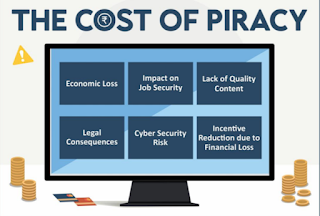PIRATED CONTENT ON DIGITAL PLATFORMS
This article covers “Daily Current Affairs” and the topic details “ Pirated content on digital platforms”. This
topic has relevance in the Governance section of the UPSC CSE exam.
For Prelims:
About Content Piracy?
For Mains:
GS 2: Governance
Key Information about Pirated content regulation?
Rationale for Regulation?
Why in the news?
The government has recently appointed nodal officers responsible for issuing orders to remove pirated
content from digital platforms and has introduced robust measures to combat film piracy.
Background:
The recent decision to combat film piracy comes after the passing of the Cinematograph Amendment
Bill 2023 in Parliament.
Currently, there exists no direct institutional framework for addressing pirated film content, except
for legal action under the Copyright Act and the Indian Penal Code (IPC).
Key Information:
The government has appointed 12 nodal officers within the Ministry of Information and
Broadcasting and the Central Bureau of Film Certification (CBFC) to handle complaints related to
film piracy. These officers are mandated to take action within 48 hours upon receiving a complaint.
Those involved in piracy may now face fines ranging from INR 3 lakh to five percent of the gross
audited value of production.
Copyright holders or their authorized representatives can apply to the nodal officers to have pirated
content removed.
If a complaint is submitted by a non-copyright holder, the Nodal Officer may conduct hearings to
determine the complaint’s validity before issuing directives.
Targeted Platforms:
Digital platforms such as YouTube, Telegram channels, websites, and other online platforms are
legally required to remove internet links containing pirated content.
Understanding Content Piracy:
Content piracy involves the unauthorized duplication of copyrighted content, which is then
distributed in the ‘grey’ market at significantly lower prices.
The proliferation of the internet and the widespread desire for free access to film content have
contributed to the rampant growth of piracy.
Rationale for Regulation:
The increase in piracy is attributed to easy access to technology and the desire for free access to film
content. These measures aim to empower authorities to swiftly address piracy, providing relief to
the industry.
The Cinematograph Amendment Bill 2023 aims to address film piracy, a long-standing demand of
the film industry. This Act was last significantly amended in 1984 and has been updated after 40
years to include provisions against film piracy, encompassing digital piracy.
In India, legal actions against piracy are covered by various laws, including the Indian Penal Code,
the Cinematograph (Amendment) Bill 2023, and the Information Technology Act of 2000. These
statutes prescribe penalties, imprisonment, and fines for those involved in film piracy and
unauthorized online distribution of copyrighted content
Q.1 Consider the following statements regarding the measures to combat film piracy in India:
1. Twelve nodal officers have been appointed to manage piracy-related complaints, with a mandatory
48-hour response time.
2. Those involved in piracy may face fines ranging from INR 3 lakh to five percent of the gross audited
value of production.
3. Cinematograph Amendment Bill 2023 deals with piracy related matters
How many of the above statement/s is/are correct?
(a) Only one
(b) Only two
(c) All three
(d) None
ANSWER: C
Q.2 Discuss the impact of digital piracy on intellectual property rights (IPR) and the creative
industries. How can governments and international organizations enhance the protection of IPR
in the digital age while also balancing the right to access information


Comments
Post a Comment